The U.S. Securities and Exchange Commission has opened the window for comments on three ether spot exchange traded fund (ETF) proposals.
Fidelity Adds Staking to Ether ETF Application, Sending LIDO Up 9%
Money management giant Fidelity wants to allow traders of its potential ethereum fund to be able to stake some of the assets, it wrote in an amendment with the U.S. Securities and Exchange Commission (SEC).
Fidelity’s Bitcoin Fund Becomes Fifth Most Popular of All ETFs in 2024
Fidelity’s Wise Origin Bitcoin Fund (FBTC) is the fifth most popular exchange-traded fund (ETF) on the market right now, attracting more than $6.9 billion since its introduction on Jan. 12, according to data from Bloomberg Intelligence.
Bitcoin ETFs See Record $1 Billion Inflows, Pushing Price Over $73,500
Yesterday, the Bitcoin price journey resembled a high-intensity rollercoaster ride, initially soaring past the $73,000 mark before encountering a tumultuous liquidation event. This event saw over $361 million worth of leveraged trades unwound, compelling the BTC price to retract sharply to below $68,300.
The drastic price fluctuation primarily affected long position holders—investors who speculated on a continued price rise—with a staggering $258 million wiped out. Subsequently, Bitcoin’s price staged a remarkable V-shaped recovery, during which short sellers found themselves on the losing end, with just over $103 million in positions liquidated.
This data by Coinglass marks the event as the most significant purge of long positions since March 5. At that time, Bitcoin experienced a decline to $60,800 following its climb to a then all-time high of approximately $69,000.
Bitcoin ETFs Register Record $1 Billion Inflows
Perhaps spurred by the opportunity presented by the price dip, investors in spot Bitcoin Exchange-Traded Funds (ETFs) engaged in a buying spree, unprecedented in its intensity. For the first time, spot Bitcoin ETFs witnessed a daily inflow surpassing $1 billion on Tuesday, March 12, primarily driven by an inflow of $849 million to BlackRock’s IBIT. According to detailed data released by Farside Investors, the total net inflows across all Bitcoin ETFs were at $1045 million (or $1.045 billion).
The second largest Bitcoin ETF to date, Fidelity, saw a rather quiet day with FBTC taking in only $51.6 million, while Ark Invest ($93 million), Bitwise ($24.6 million), Valkyrie ($39.6 million) and VanEck ($82.9 million) saw relatively strong capital inflows. Notably, Grayscale‘s GBTC saw a waning outflow of just $79 million.
Bitcoin analyst Alessandro Ottaviani shared his insights on X, underscoring the magnitude of these inflows, “1 Billy of Total net Inflow! ONE BILLION DOLLARS! […] In the last twelve trading days, The Nine inflow has been $9.2b, with an average of $768m per day. Just imagine if we keep this pace and it is confirmed that GBCT outflow is almost exhausted.”
Crypto Quant analyst Maartunn provided additional context to the inflow’s impact, revealing, “JUST IN: The Bitcoin Exchange-Traded Fund (ETF) has experienced its highest inflows ever, with an additional 14,706.2 BTC.” This statement further emphasizes the substantial increase in Bitcoin’s demand, potentially setting it up for a major supply squeeze.
JUST IN: The Bitcoin Exchange-Traded Fund (ETF) has experienced its highest inflows ever, with an additional 14,706.2 BTC. https://t.co/xg7wADbRzy pic.twitter.com/IUAyt1jzGE
— Maartunn (@JA_Maartun) March 13, 2024
Adding to the conversation, crypto analyst @venturefounder suggested potential future price movements based on the current trend, “Absolute Bitcoin madness […] The 5-day moving average net inflow has fully recovered to peak. So… probably HIGHER. If this continues, $80-90k by the end of month is not far fetched. No correction has lasted longer than 24 hours on the weekdays. Interestingly, the first major correction of the 2021 cycle came when price went 2x previous ATH. So could we see no major correction until $120k?”
At press time, BTC already surpassed the $73,500 mark and traded at $73,392.
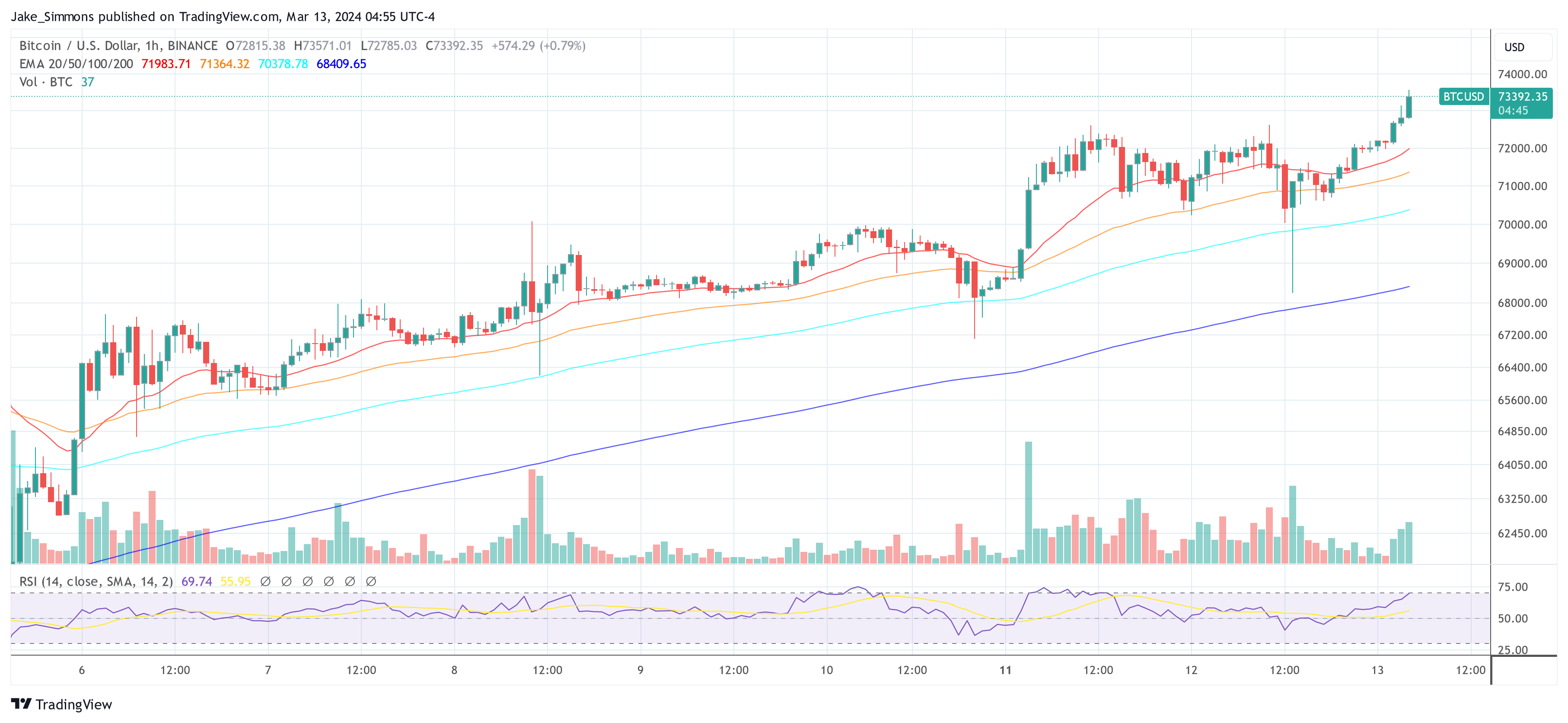
SEC Pushes Back Decision on BlackRock, Fidelity’s Ether ETF Applications
The SEC wants to know if the applications for ETFs that hold Ethereum’s ether (ETH) are supported by the same arguments that led to the approval of spot bitcoin ETFs.
Expert Predicts Bitcoin At $750,000 As Fidelity Advises 1-3% Allocation
In a major shift within the financial industry, Fidelity Investments, with its colossal $12.6 trillion in assets under administration, is now recommending that the traditional 60/40 portfolio model should evolve to include a 1-3% allocation to crypto, specifically through its spot Bitcoin ETF (FBTC). This groundbreaking move is not just a nod to the burgeoning crypto market but a potential catalyst for unprecedented demand, potentially channeling hundreds of billions of dollars into Bitcoin.
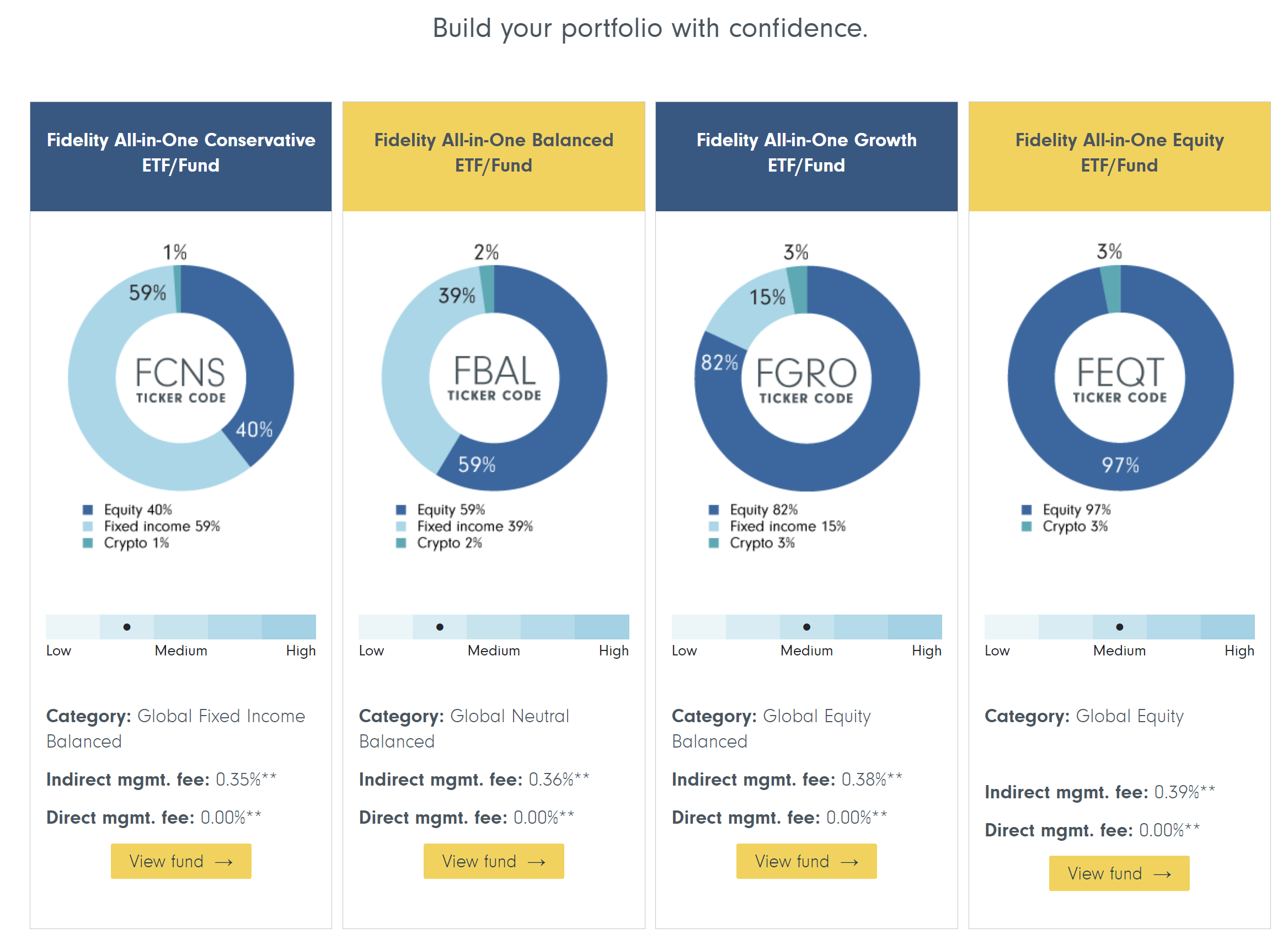
Matt Ballensweig, Head of Go Network at BitGo, took to X (formerly Twitter) to express his anticipation, stating, “I’ve said this since the day of ETF approval – now that Pandora’s box has been opened, the multi-trillion dollar asset managers will sell BTC and crypto through their massive distribution channels for us. Fidelity now creates blueprint portfolios with 1-3% crypto.”
Echoing this sentiment, Will Clemente III, a renowned analyst, remarked on the potential ripple effects of Fidelity’s recommendation. “Fidelity now recommending a 1-3% crypto allocation in your portfolio. Gateway drug. What happens when that 1-3% becomes 3-6%? Slowly then suddenly,” Clemente noted, highlighting the potential for growth in crypto allocation.
What This Could Mean For Bitcoin Price
Adam Cochran, a partner at CEHV, further elaborated on the implications of Fidelity’s move for Bitcoin’s adoption and price trajectory. In a detailed analysis shared on X, Cochran laid out an ambitious future where the inclusion of crypto in traditional portfolios could lead to a substantial reevaluation of Bitcoin’s value. “How fucking wild is this to see. 60/40 portfolios are now 59/39/2,” Cochran began, underlining the historic milestone of crypto becoming a core asset class.
Cochran compares the adoption rates of the internet to cryptocurrency, stating, “Hell, the internet was 30 years in the making and didn’t reach 10m users till 1995. But the most non-conservative estimates put crypto ownership at 450M worldwide (conservative is more like 200M) that’s like the internet in 2001.”
He highlights the outsized economic impact of digital advancements, “Today the internet has somewhere around 5.5B users – 12x what it did in 2001. But according to BEA, the impact of the digital economy has been exponentially outsized with each year of growth.” By drawing this parallel, Cochran sets the stage for a crypto market that could see exponential growth in value and influence.
Cochran’s approach to calculating Bitcoin’s future valuation involves analyzing the potential influx of funds from traditional investments. “If that follows the change to 59/39/2, you’re looking at $1.6T in new buying… Given the current market is $2.24 trillion total marketcap… we get a cash to value rate of 9.3%.”
The core of Cochran’s analysis lies in his valuation prediction, where he states, “Prorata between coins at their current ratios and that’s $748,500 BTC and $43,635 ETH in raw spot buying. But since we know notional causes things to run, and we’ve got things like ETH’s yield demand and burn, we’re usually several multiples above the price of our raw spot demand.”
Cochran’s conclusion reflects a strong belief in the transformative potential of cryptocurrencies within traditional investment portfolios. “At the end of the day, even gold hasn’t broken into the 60/40 portfolio in a meaningful way, so I think blowing past the $12T mcap of gold by a good multiple over time is a no-brainer.”
At press time, BTC traded at $57,175.
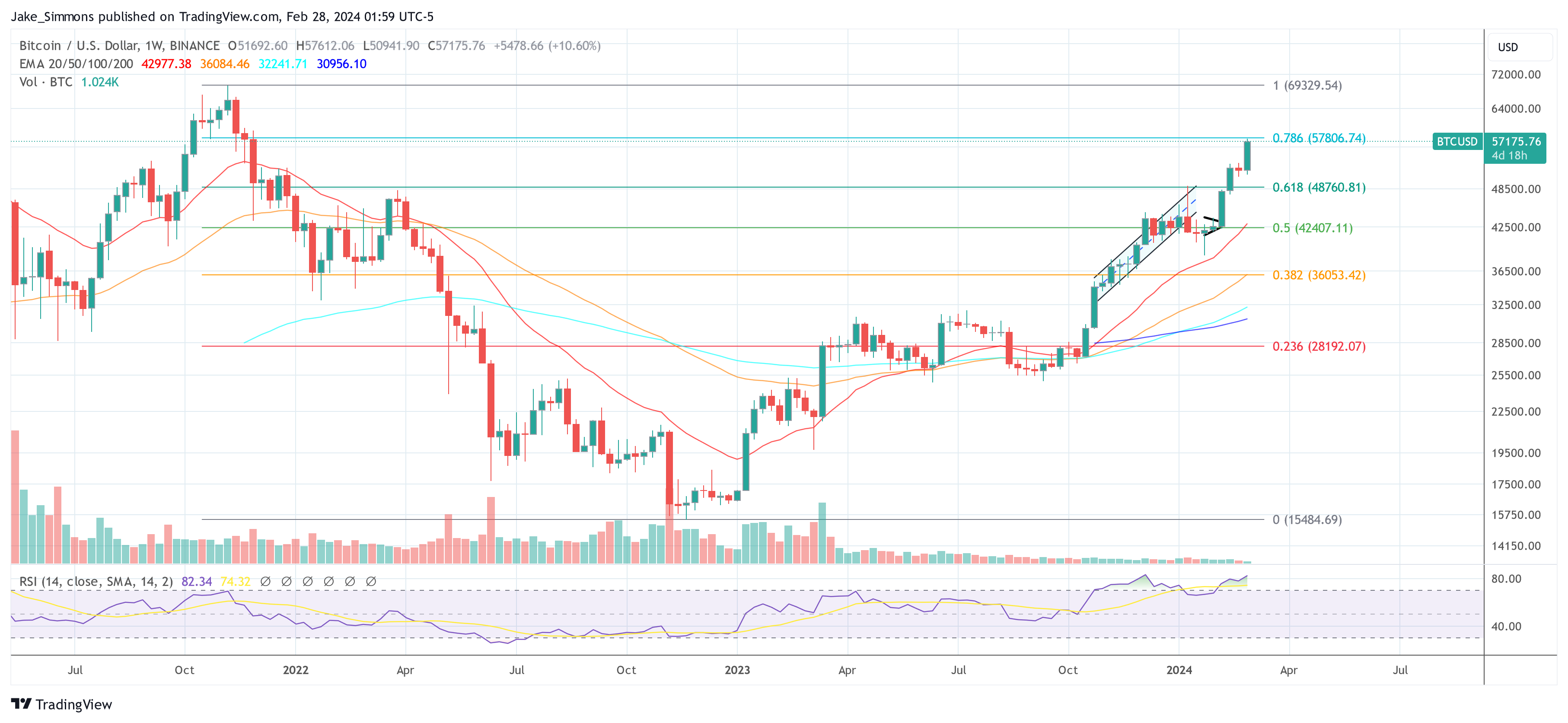
Former Fidelity Digital Assets Head Joins Advisory Board of Ethereum L2 Layer N
Luc Froehlich will help guide Layer N’s Real World Asset, TradFi, and tokenization strategies.
Bitcoin Continues To Break Wall Street Records: The Whales Are Here
Bitcoin is making waves on Wall Street, with BlackRock and Fidelity, two of the popular spot Bitcoin exchange-traded funds (ETF) issuers shattering records. Looking at recent trends, spot Bitcoin ETFs are surging in popularity, indicating that institutional investors, or “whales,” are diving headfirst.
Fidelity And BlackRock Spot Bitcoin ETFs Break Wall Street Record
Mark Wlosinski, a crypto commentator, took to X on February 12, highlighting the meteoric rise of BlackRock (IBIT) and Fidelity (FBTC) Bitcoin spot ETFs. Both have amassed a staggering $3 billion in assets under management (AUM) within 30 days. This feat is historic, marking the first time an ETF of any product has achieved such rapid growth in such a short period.
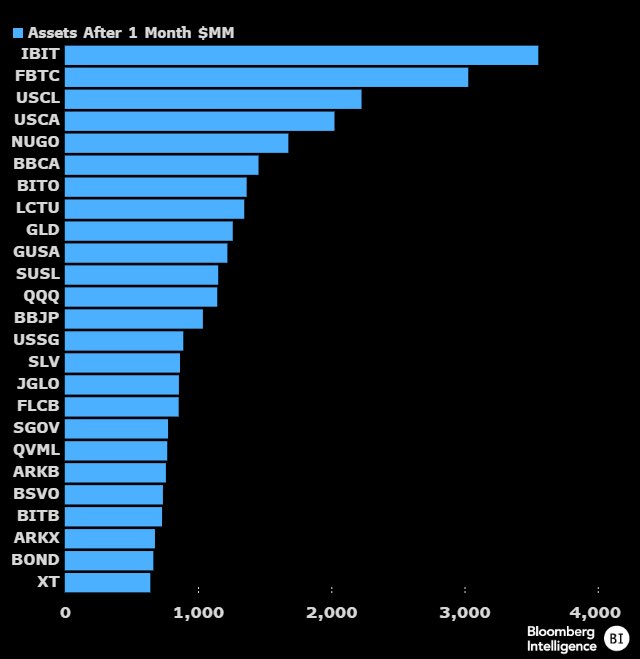
This unprecedented demand for spot Bitcoin ETFs comes amidst a broader trend of institutional adoption. Wlosinski notes that over 5,500 ETFs have been launched throughout history. However, none have yet witnessed the level of enthusiasm currently surrounding spot Bitcoin ETFs.
The pace at which BTC AUM of spot ETF issuers continues to grow suggests a significant shift in investor sentiment. Specifically, Wall Street is increasingly recognizing BTC’s potential as a viable asset class.
For years, leading Wall Street executives, including Jamie Dimon, the head of JP Morgan, dismissed the coin, saying it was speculative and a scam. However, with the United States Securities and Exchange Commission (SEC) approving spot Bitcoin ETFs after more than ten years of rejecting the product, there appears to be a seismic shift in the investment landscape.
As of February 12, Lookonchain data shows that Fidelity and Ark21 Shares bought an additional 6,822 BTC worth over $339 million. BlackRock’s IBIT remains the largest spot BTC ETF by AUM, controlling over 87,780 BTC. However, spot ETF issuers continue to accumulate, pushing their total haul to 682,448 BTC.
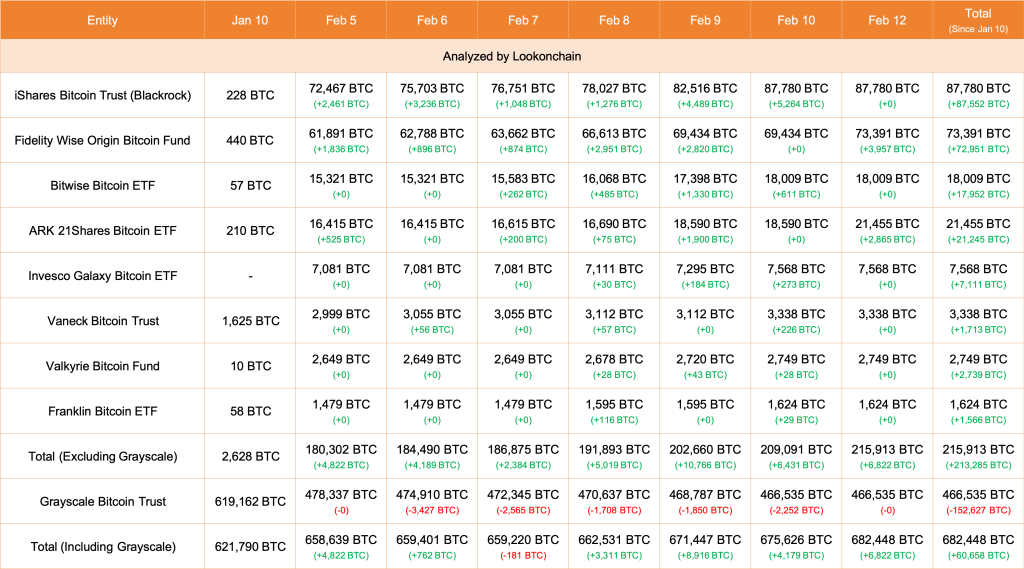
BTC Retests $50,000, Path To November 2021 Highs?
Since spot Bitcoin ETFs track the spot price, the more spot ETF issuers buy, the higher the demand for the coin becomes. Accordingly, rising demand has significantly impacted prices, as the daily chart shows. So far, Bitcoin is trading close to the psychological $50,000 mark, the highest level since 2024.
Technically, the uptrend remains, and buyers are firmly in control. If buyers double down, buy more, and take more coins out of the reach of spot ETF issuers, Bitcoin will likely float to $70,000 or better in the sessions ahead.
Related Reading: SOL Price Surges To $115 – Why Solana Could Rally Another 10%
Analyst: After Bitcoin Hits $50,000, Expect Another 100% to 200% Rally
David Krueger, a crypto analyst on X, thinks Bitcoin (BTC) will tear higher, surging by 100% to 200% within five months, fueled primarily by fear of missing out (FOMO) once the coin breaks above $50,000.
Will Bitcoin Break Above $50,000 And Rally To $100,000?
Citing Tom Lee’s historical analysis, Krueger believes FOMO typically kicks in when Bitcoin trades above a price level “exceeding 97% of its historical days.” Lee is the co-founder and researcher at Fundstrat.
Zooming at the development in the monthly chart, the analyst notes that this price point sits at $50,000, a key psychological level that bulls have failed to overcome since the bull run from mid-November 2023.
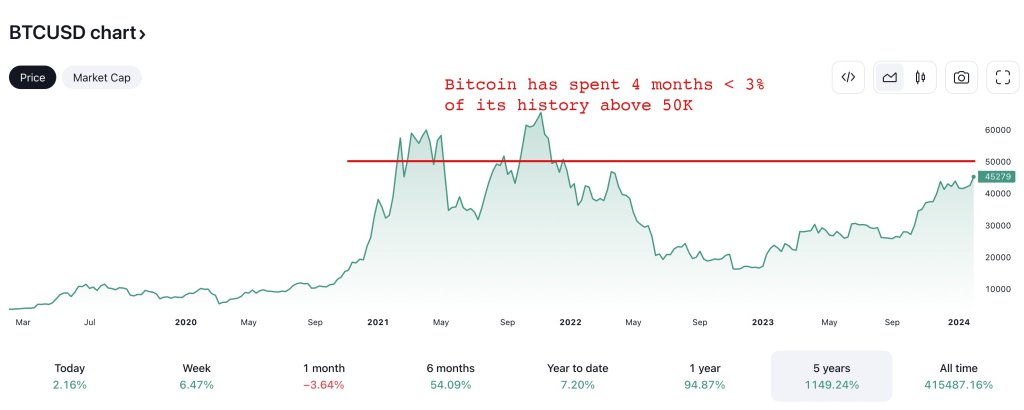
Accordingly, if Lee’s analysis and the analyst’s assertion come true, BTC prices will likely float higher in the sessions ahead. However, what’s unclear is when BTC will clear this $50,000 level, paving the way for $100,000 and even $200,000 five months after the decisive breakout.
When writing, BTC prices are firm and rallying. The coin is trending above $46,500 and will likely clear above January 2024 highs of around $48,700. Even so, whether the current uptrend will cause excitement, possibly creating FOMO, is yet to be seen.
Looking at Google Trends data and organic search related to Bitcoin, interest is fizzling out. Data shows that the number of people searching for Bitcoin in the United States has dropped and is at around early 2021 levels. Even so, around that time, Bitcoin prices began trending higher, eventually rising to as high as $69,000.
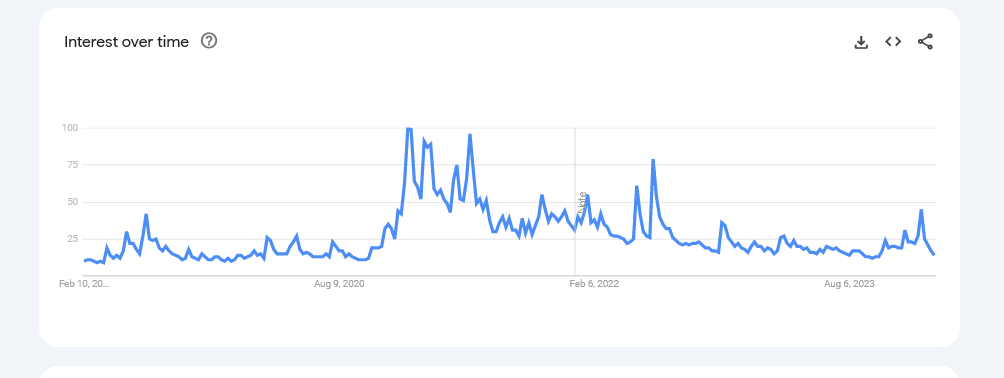
Halving And Spot ETF Issuers Loading Up More Coins
While FOMO appears elusive at spot rates, another analyst offers a different perspective. In response to Krueger’s outlook, the analyst notes that sharp interest in Bitcoin historically arrives around six months after halving, lasting up to 18 months. This event and steady or increasing demand create a supply-demand imbalance that may pump prices.
Bitcoin will halve its miner rewards in early April 2024. It is an event that may anchor bulls, setting the base for more gains as projected by analysts.
The coin might also edge higher considering the pace at which spot Bitcoin exchange-traded fund (ETF) issuers have been buying BTC in the past few weeks since the product was approved in mid-January 2024.
With Wall Street players like Fidelity, BlackRock, and other crypto firms like Bitwise loading up more coins, BTC will likely be more scarce than it has been after past halving events.
Blackrock, Fidelity Bitcoin ETFs Have a Liquidity Edge Over Grayscale: JPMorgan
GBTC is expected to lose further funds to newly created ETFs unless there is a meaningful cut to its fees, the report said.
Why Is Bitcoin Price Not Going Up Despite The ETFs? Expert Explains
In a recent analysis, Fred Krueger, the former founder and chairman of Traffic Marketplace, offered a nuanced explanation for the seemingly paradoxical situation where the Bitcoin price has fallen despite the influx of over $5 billion in new assets through Exchange-Traded Funds (ETFs) by BlackRock and Fidelity. Since January 11, the first trading day of the ten spot ETFs, the Bitcoin price has currently plunged by 13% (over 21% at times).
Why Is Bitcoin Price Not Going Up?
Krueger’s insights, shared via X (formerly Twitter), delve into the complex dynamics of the market and its recent interactions with emerging financial instruments. Krueger’s analysis begins by highlighting a key strategy adopted by arbitrage traders in late June 2023, in anticipation of the ETF launch.
He stated, “In late June 2023, in anticipation of an ETF, arbitrageurs put on Long GBTC, short BTC Futures trades.” This maneuver, according to Krueger, initially had a negative impact on Bitcoin’s price. However, its effects were masked by the overall market rally at the time.
Crucially, this strategy began to close the discount on Grayscale Bitcoin Trust (GBTC) and simultaneously increased the open interest on the Chicago Mercantile Exchange (CME). With the approval of the ETFs, these arbitrage traders shifted their strategies. Krueger explains, “Once the ETFs were approved, the arbs unwinded the trade. This time they sold GBTC for BTC, and bought Futures.”
He describes this action as market-neutral. The selling of GBTC necessitated an actual sale of Bitcoin, which balanced against the futures purchase. This dynamic led to a decrease in the open interest on CME, a trend that was observed and reported.
There Was More At Play
Krueger also sheds light on the composition of the new ETF demand, noting that “about 1.5 billion of the 5 billion in new ETF demand was in fact recycled from GBTC in tax-neutral accounts, looking for lower fees.” This recycling of funds, while significant, did not represent fresh capital entering the Bitcoin market but rather a reallocation of existing investments.
The analysis further identifies external market pressures, notably the selling of $1 billion worth of GBTC by Sam Bankman-Fried (SBF), founder of FTX. Krueger comments, “This selling, and the headline selling of GBTC spoofed the market, and so people concluded the ETF was a failure.”
However, Krueger argues that this perspective overlooks the reality that the ETFs actually created net new buying pressure of over $3.5 billion. Despite the substantial buying activity spurred by the new ETFs, the broader market reaction was influenced by a combination of factors, including the FTX selling and the unwinding of arbitrage positions.
Krueger concludes his analysis by stating, “The relentless buying of the new ETFs was far bigger than anybody predicted, modulo the FTX selling and the arb unwinds.” Overall, Krueger is super bullish:
Over the next 30 to 60 days, there are 20 to 40 trading sessions. I would bet this results in between 4 and 6 Billion new USD in inflows. At a market cap of 850 Billion, it’s pretty easy to see this *could* move the market 50% or to 64K. Basically at all time high.
At press time, BTC traded at $43,054.
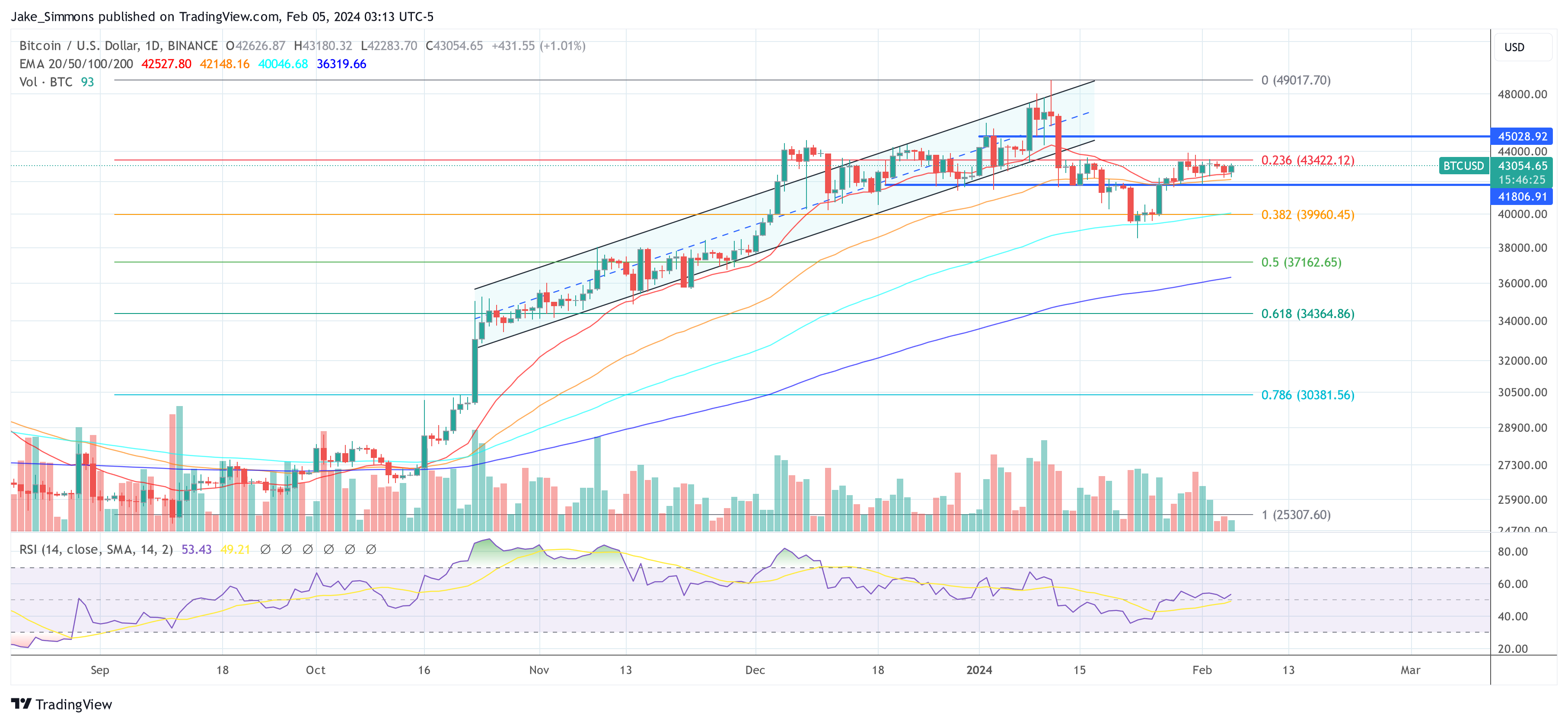
Analyst Predicts Shocking Bitcoin Price By Year-End Based On ETF Inflows
In an analysis released via X, Thomas Young, managing partner at RUMJog Enterprises, is projecting a staggering upward trajectory for Bitcoin’s price by the end of the year, basing his predictions on the influence of Bitcoin Exchange-Traded Funds (ETFs) inflows. As NewsBTC reported, Grayscale’s GBTC outflows have slowed down significantly recently, resulting in constant net inflows over the past five consecutive days,ranging from $14.8 million to $247.1 million.
The 118 Multiplier Concept
The crux of Young’s analysis hinges on the concept of the ‘118 multiplier’, a metric introduced by Bank of America in March 2021. This multiplier posited that an investment influx of approximately $92 to $93 million was needed to move Bitcoin’s price by 1%. At that time, Bitcoin’s market capitalization was approximately $1.09 trillion, corresponding to a unit price of around $58,332.
Young’s forecast revisits and modifies this concept, emphasizing its non-static nature. He notes, “The Multiplier is a result of several interacting variables, including the volume and velocity of capital inflow, the readily tradable supply of Bitcoin, and external factors affecting risk metrics in the broader market.” Thus, the 118x multiplier is suggested to be a dynamic, rather than a fixed, indicator.
Drawing on data from HODL15Capital, Young observes a consistent growth in Bitcoin ETFs, averaging an influx of 4,193 BTC per day. This translates to approximately $176 million of net new capital daily. For forecasting purposes, Young adjusts this figure to $150 million daily, spread uniformly across the trading days of each month (typically 20-23 days).
Bitcoin Price Could Reach $131,000 By EOY
Applying a more conservative multiplier of 50x, as opposed to the original 118x or 100x, Young calculates an estimated monthly upward price pressure of $8,000 per Bitcoin. This calculation leads to a year-end price target of at least $131,000 for Bitcoin. Young states, “This $131K represents the lower bound of the forecast, acknowledging that actual capital flow may not be uniform and other factors could increase the multiplier.”
The adjusted analysis also takes into account the irregularities observed in January, particularly the one-time selling of GBTC. Young revised the January data to provide a more accurate representation of the trend for the remainder of the year. He suggests, “A rule of thumb: the daily average BTC gain across all ETFs times $2 gives a conservative estimate of the ETF growth’s price effect.”
Based on this model, Young’s monthly Bitcoin price predictions, assuming ETF inflows continue at the rate observed in the first 15 days, are as follows:
- January: $42,000
- February: $50,022
- March: $58,044
- April: $66,448
- May: $74,852
- June: $82,492
- July: $90,896
- August: $99,300
- September: $106,940
- October: $115,726
- November: $123,366
- December: $131,388
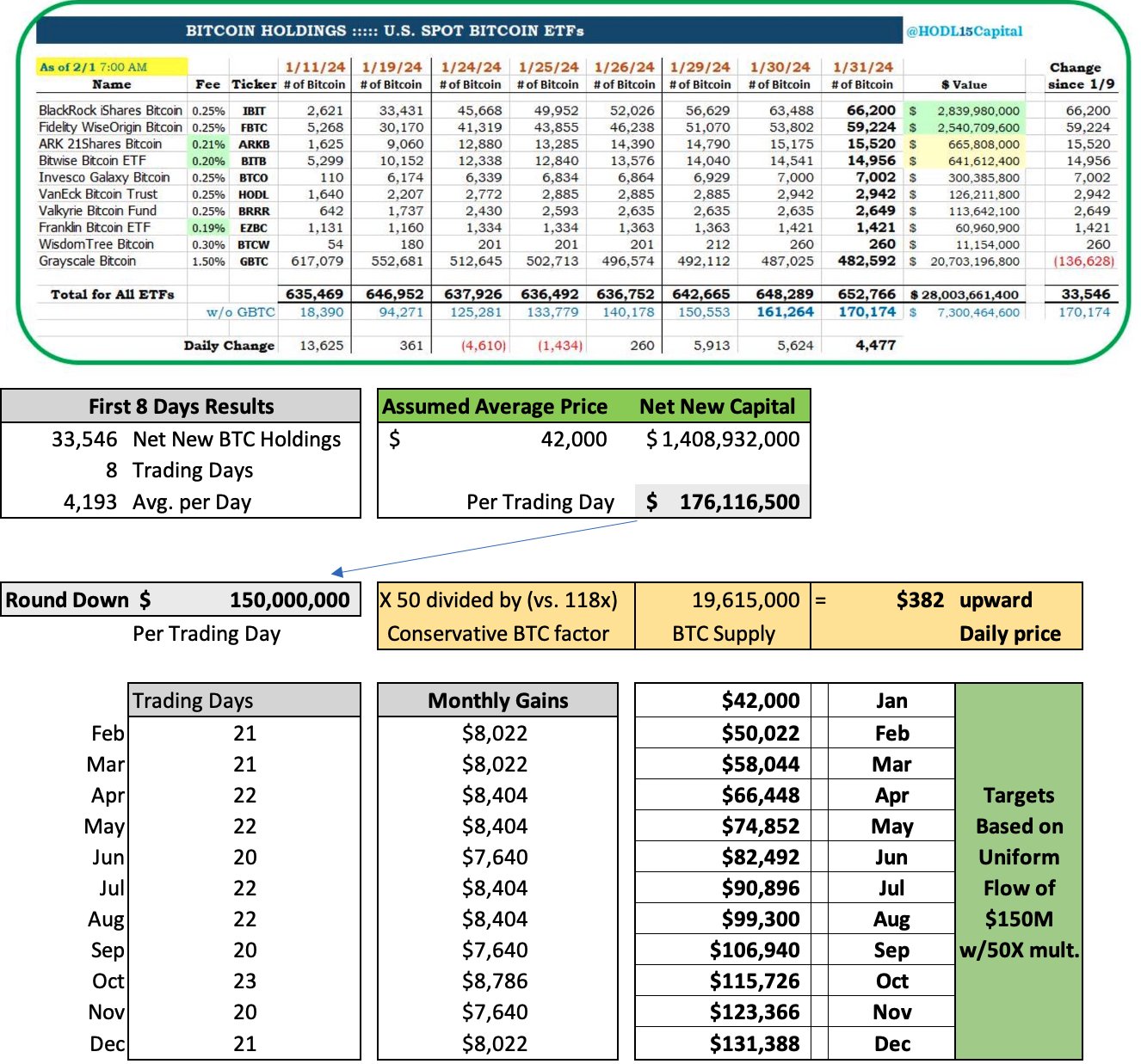
This meticulous analysis from Young not only highlights the potential impact of ETF inflows on Bitcoin’s price but also underscores the complexity and dynamic nature of cryptocurrency markets. However, other events that affect supply and demand dynamics, such as the next BTC halving, as well as macroeconomic developments (Fed rate cuts), among others, are other factors that make price predictions incredibly difficult.
At press time, BTC traded at $43,021.
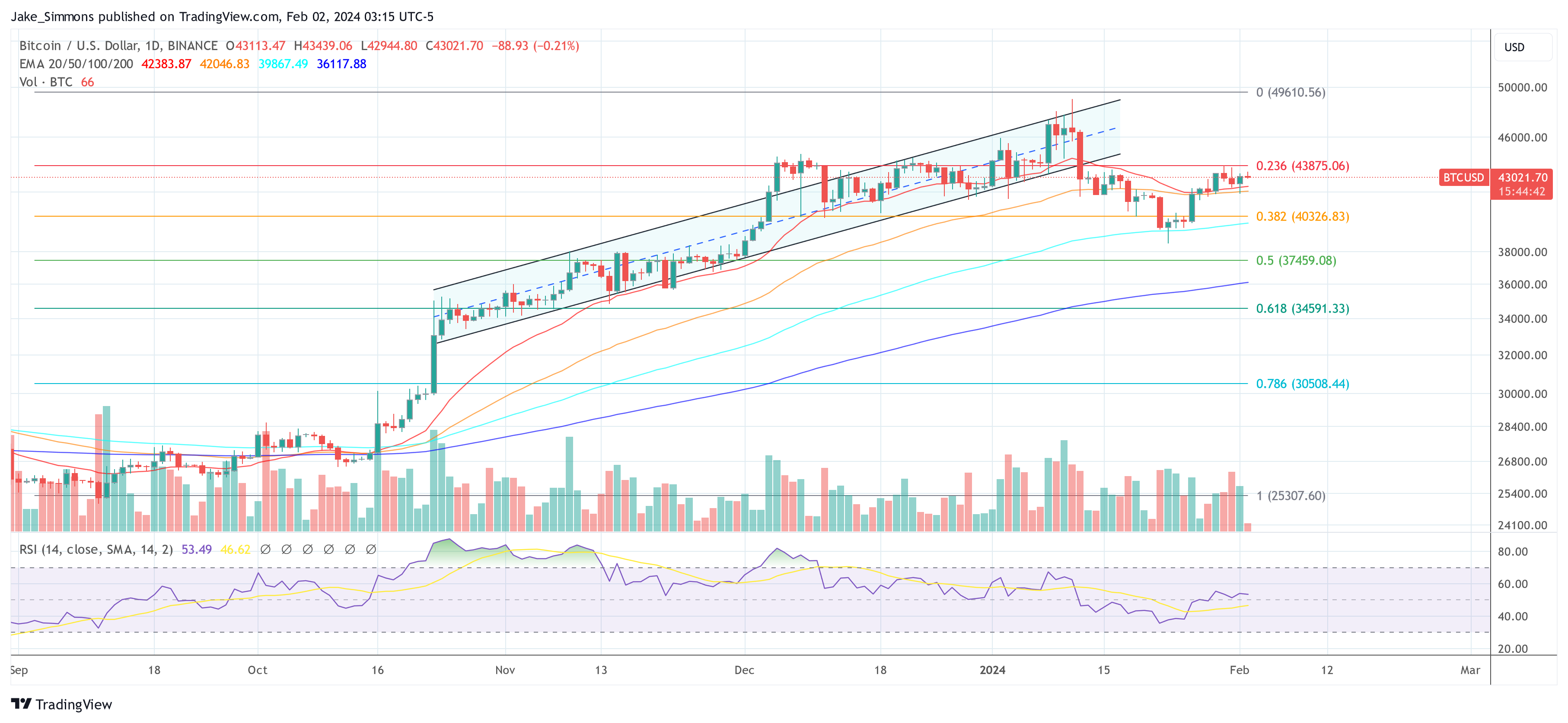
Bitcoin ETF Flows Show Negative Trend For First Time Since Launch
The group of recently launched spot bitcoin exchange-traded funds (ETFs) are seeing combined negative flows for the first time since they opened for trade on Jan. 11 as money moving into funds like BlackRock’s IBIT and Fidelity’s FBTC has failed to keep pace with the exits from Grayscale’s GBTC.
Bitcoin ETF Day 8 Update: Market Rebound Signals Bottom As Grayscale Selling Slows Down
Since the approval of Bitcoin ETF applications by the US Securities and Exchange Commission (SEC) on January 11, followed by the commencement of trading a day later, the ETF race has witnessed impressive trading volumes on each trading day.
As the market recovers from a sharp correction, recent developments indicate a notable slowdown in Grayscale selling, which could potentially signal a rebound for the Bitcoin price following the recent 20% drop.
Market expert James Mullarney and Bloomberg ETF expert Erich Balchunas provide key insights into Bitcoin ETF fund flows after 8 days, shedding light on the evolving dynamics and investor sentiments surrounding this development.
Hope For Bitcoin Bulls
One of the key observations made by James Mullarney is the deceleration in Grayscale’s selling activities. While Grayscale continues to sell, the pace of their selling has significantly reduced, indicating a potential shift in their strategy.
This is seen as a positive sign for the market, as a slowdown in Grayscale selling could contribute to stabilizing Bitcoin prices and restoring investor confidence.
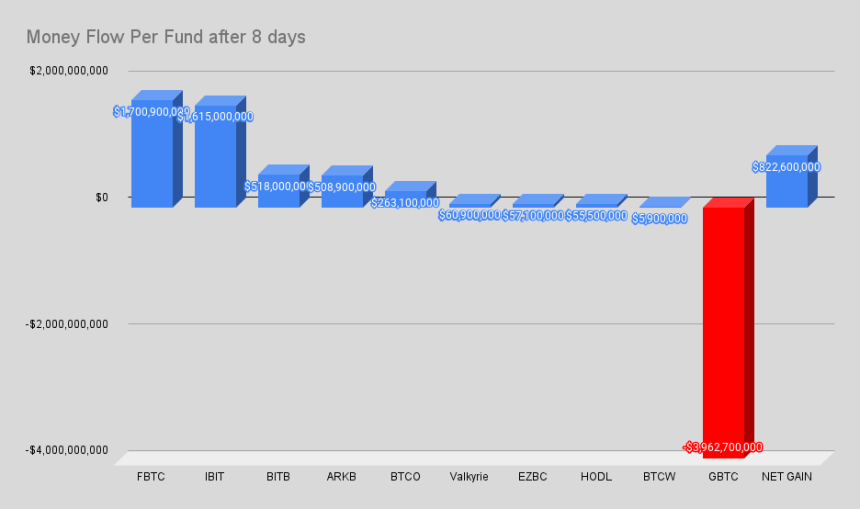
Amidst this backdrop, major players in the asset management industry, such as BlackRock and Fidelity, have showcased their resilience and commitment to Bitcoin.
BlackRock, one of the world’s largest asset managers, currently holds 44,000 BTC in assets under management (AUM), indicating their growing exposure to the cryptocurrency.
Similarly, Bitcoin ETF issuer Fidelity, renowned for its digital asset services, stands strong with 40,000 BTC AUM, demonstrating their continued confidence in Bitcoin and its long-term potential.
Moreover, the dynamics of the recent sell-off are noteworthy. The majority of the selling pressure observed in the market involved FTX, which completed day 8 of trading.
However, as the market enters day 9, the expectation is for a significant reduction in selling pressure from FTX and Grayscale, potentially contributing to a more stable market environment, according to Mullarney.
The emergence of Bitcoin ETFs as significant holders of the cryptocurrency is another positive aspect to consider. ETFs have not only absorbed the 101,600 BTC sold by Grayscale but have also increased their holdings by an additional 21,100 BTC in just 8 days.
According to Mullarney, this indicates growing institutional interest in Bitcoin, as ETFs continue to accumulate significant amounts of the cryptocurrency.
Bitcoin ETF Issuers Counter Grayscale Selling
Despite Grasycale’s selling spree, Mullarney highlights that the Bitcoin ETF managers alone are acquiring 15 times the daily Bitcoin supply, surpassing 13,444 BTC against the 900 BTC daily creation rate.
This notable inflow of BTC demonstrates the strong demand from institutional investors and highlights the potential impact of ETFs on the overall Bitcoin market.
Interestingly, the new ETFs have absorbed a net total of 122,000 BTC in just 8 days, overcoming the impact of Grayscale’s release and contributing to a positive net inflow.
Bloomberg ETF expert Erich Balchunas adds further insights to the analysis. Balchunas notes that the volume of Grayscale Bitcoin Trust (GBTC) has decreased, which could be a sign of exhaustion in selling.
However, $515 million was withdrawn from GBTC yesterday, resulting in a total outflow of $3.96 billion since its conversion to an ETF. On a more positive note, there was a net inflow of $409 million on the ninth day, indicating renewed investor interest.
Featured image from Shutterstock, chart from TradingView.com
Fidelity Bitcoin Spot ETF Records $1 Billion In Net Inflows – Details
Data from the trading analytics platform BitMEX Research reveals that Fidelity’s Bitcoin spot ETF – FBTC – has now witnessed a total inflow of over $1 billion. This development comes as BTC attempts to rebound from its recent dip over the last two weeks with a 1.56% gain in the past day, based on data from CoinMarketCap.
Fidelity Joins BlackRock On Exclusive $1-B List, As Grayscale’s ETF Continues To Bleed
Following the official launch of Bitcoin spot ETF trading on January 11, Fidelity has now become the second asset manager, with its BTC spot ETF recording an accumulative inflow of $1 billion. According to BitMEX Research, Fidelity’s FBTC experienced an inflow of $177.9 million on January 18, bringing its total inflows to $1.1 billion within five days of trading.
FBTC now sits at the same table as BlackRock’s IBIT, whose total inflows are valued at $1.2 billion. Together, both investment funds by Fidelity and BlackRock now account for over 67% of the $3.4 billion inflows recorded in the Bitcoin spot ETF market so far.
Other Bitcoin spot ETFs with a notable positive performance include Bitwise’s BITB, Ark Invest’s ARKB, and Invesco’s BTCO, which have posted individual total inflows of $395.5 million, $320.9 million, and $194.8 million, respectively.
Bitcoin Spot ETF Flow data – Day 5
Data out for all providers
Net outflow of $131.6m on day 5 for all spot ETFs, large $579.6m GBTC outflow pic.twitter.com/McHZrRghtu
— BitMEX Research (@BitMEXResearch) January 19, 2024
On the other hand, Grayscale’s GBTC continues to experience outflows on a massive scale.
BitMEX Research reveals that GBTC recorded an outflow of $579.6 million on January 18, leading the Bitcoin spot ETF market to witness a net outflow of $131.6 million. This represented the second day the BTC spot ETF market recorded a net outflow since its launch.
GBTC’s total outflows are now valued at $2.1 billion, resulting in Bitcoin spot ETFs having a cumulative net inflow of only $1.3 billion despite the $1 billion status of BlackRock and Fidelity’s ETFs.

Bitcoin’s Price Overview
Against popular predictions, Bitcoin has witnessed a price decline in the last two weeks following the approval of the much-anticipated BTC spot ETF on January 10. Many analysts have attributed this unexpected development to the massive selling pressure generated by GBTC’s outflows.
At the time of writing, Bitcoin trades at $41,536, with a decline of 2.55% and 5.50% in the last seven and 14 days, respectively. As earlier stated, the premier cryptocurrency has garnered some gains of 1.56% in the last day, which may be indicative of a recovery, however, it is too early to call.
Fidelity’s Jurrien Timmer Says Bitcoin to Consolidate Recent Gains Amid ETF Hangover
Some have forecasted sharp declines in bitcoin’s price as traders ‘sell the news’ post-ETF approval, but Fidelity’s Director of Global Macro disagrees.
Bitwise, Fidelity, BlackRock See Biggest Bitcoin ETF Inflow in Preliminary Tally
Data about inflows is still incomplete and market watchers might have to wait until Friday evening for the full picture, Bloomberg analyst Eric Balchunas pointed out.
Bitcoin ETFs: What to Expect on Day One
Spot bitcoin ETFs are launching in the U.S. on Thursday. Here’s what the issuers and exchanges behind these products have to say.
Bitcoin ETFs: What to Expect on Day One
Spot bitcoin ETFs are launching in the U.S. on Thursday. Here’s what the issuers and exchanges behind these products have to say.
BlackRock, Other Potential Bitcoin ETF Providers Reveal Fees
BlackRock said its fee will start at 0.20%, rising to 0.30%.